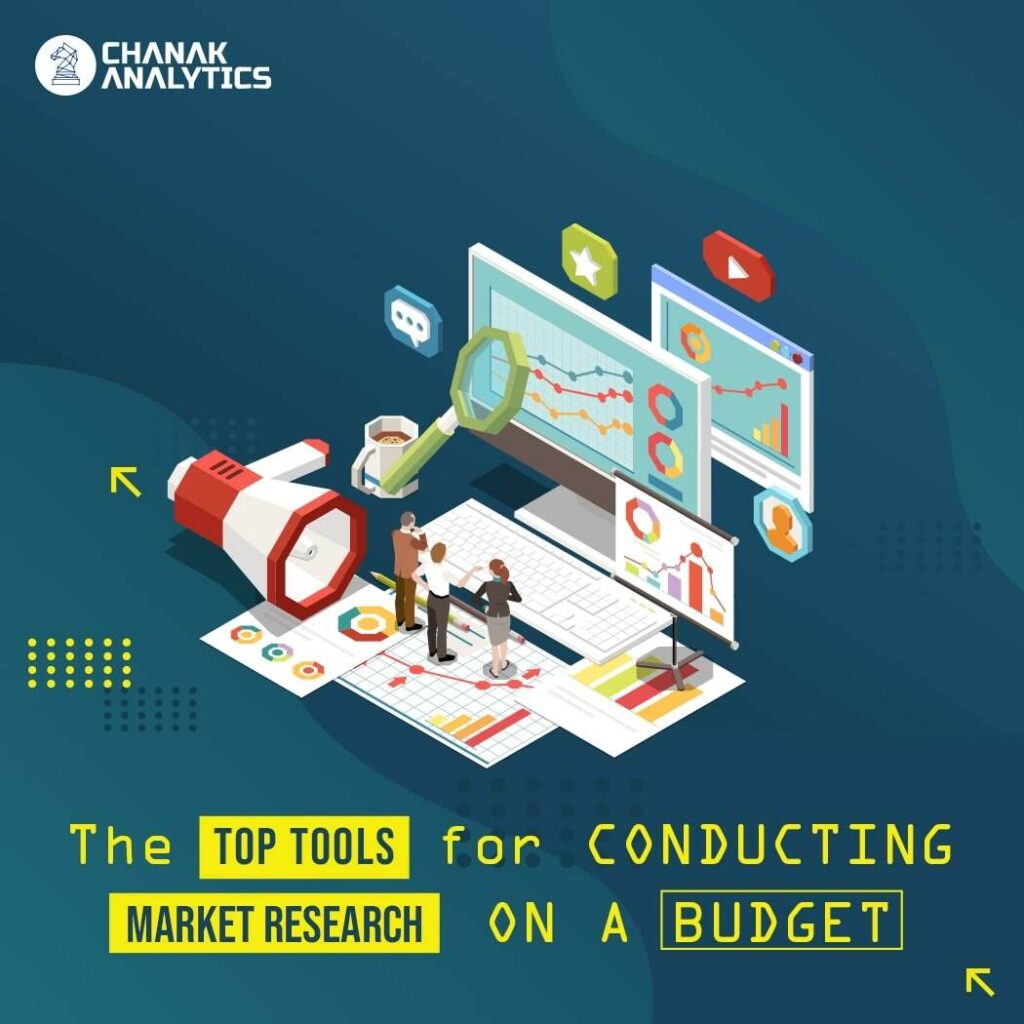The Top Tools for Conducting Market Research on a Budget


Market research is an integral part of any good marketing plan. It is the process of getting information about a target market or audience and evaluating it so that firms may make better choices. In this part, we’ll talk about what market research is, why it’s essential, and how to do a successful market research project.
What is Market Research?
Market research is getting information on a target market or audience and figuring out what it all means. This information may be utilized to find out what consumers want and need and to figure out how the market is changing and who your rivals are. There are several ways to do market research, such as surveys, focus groups, and observational studies.
Why is Market Research Important?

Market research is essential for all kinds and sizes of organizations. It helps organizations learn more about their target clients, see trends and patterns, and make judgments about their marketing plans based on accurate information. Without market research, a firm could lose out on possibilities or spend money on marketing methods that don’t work.
How to Conduct a Successful Market Research Project?
Successful market research projects require proper planning, execution, and analysis. Here are some steps to follow:
• Identify your target market and ideal customer
Knowing your ideal consumers and what they want and need is imperative. It can help you adjust your marketing plans to reach and keep your audience’s attention.
• Gather information
Information may be gathered in several ways, such as via surveys, focus groups, and observational studies. It is vital to pick the best approach for your company and the people you want to reach.
• Conduct SWOT analysis
SWOT analysis helps firms determine the pros and cons of their product or service and how to take advantage of opportunities and reduce risks.
• Create buyer personas
Buyer personas are made-up versions of the kind of people you want to sell to. They assist companies in learning more about the people they want to reach, so they can make their marketing methods more effective.
• Use budget market research tools
There are various budget market research tools available, such as SurveyMonkey, Google Surveys, and Qualtrics, that can help businesses gather and analyze data efficiently and cost-effectively.
By following these steps, a firm may run a successful market research study and learn more about its target clients, which can help it make better marketing decisions
.
How to Prioritize Your Marketing Spending
Making a marketing plan is an integral part of running a successful company. A marketing plan shows how a firm will reach its target audience and keep them interested. But if you have a small budget for marketing, it’s crucial to set priorities to get the most out of your money.
This section will look at some practical approaches to deciding how to spend money on marketing.
• Targeted Marketing Strategy
A focused marketing plan is a good technique for sending the appropriate message to the right people at the right time. By figuring out your ideal client and adapting your marketing to their requirements and tastes, you can get the most out of your marketing spend and get the most return on your investment (ROI). “segmentation” is one technique for building a focused marketing plan.
Another way to create a targeted marketing strategy is through personalization. Personalization is when you personalize your marketing to each consumer depending on how they have behaved, what they like, or how they have interacted with your company. Personalization can be done through email marketing, website customization, or personalized advertising.
• AI Marketing Tools
AI marketing solutions are another approach to prioritize spending on marketing and getting the most out of your money. AI marketing solutions employ machine learning algorithms to look at how customers act, spot patterns, and suggest marketing tactics for specific groups. These technologies help firms get the most out of their marketing strategies and reach the right people.
Adobe Target is a well-known tool for AI marketing. Adobe Target uses machine learning algorithms to look at consumer data and provide customized experiences for each customer.
Salesforce Einstein is a solution for marketing that uses AI as well. Salesforce Einstein uses AI to analyze customer data and provide insights into how customers act, what they like, and what they need.
The Best Ways to Keep Your Marketing Spending in Check

When it comes to marketing, it’s essential to keep your expenditures in control, particularly if you don’t have much money. Luckily, there are many suitable methods to achieve this, such as using content creation tools that use AI technology.
• Use AI-powered content creator tools.
Using content generator tools that AI drives is one of the best methods to keep your marketing costs in control. These technologies use machine learning algorithms to assess data and rapidly and effectively create high-quality content.
With AI-powered content creator tools, businesses can generate a wide range of content, including social media posts, email campaigns, blog posts, and more, without hiring additional staff or outsourcing to expensive marketing agencies.
• Focus on high-impact marketing channels.
Focusing on marketing channels with a significant impact is another suitable method to keep your marketing costs in control. It includes figuring out which marketing platforms provide you with the best chance of reaching your target clients and getting their leads. For example, suppose your target clients spend much time on Facebook, Instagram, and Twitter.
• Experiment with low-cost marketing tactics
In addition to focusing on high-impact marketing channels, experimenting with low-cost marketing tactics can also effectively keep your spending in check. It includes email marketing, referral schemes, and marketing via people with much power.
• Leverage user-generated content
User-generated content (UGC) is another effective way to monitor your marketing spending. UGC is any content your customers or users create, such as reviews, testimonials, and social media posts. Using UGC, you may receive high-quality material that your target clients would like without making it yourself.
• Partner with other businesses
Lastly, working with other firms might be a good strategy for controlling your marketing costs. By teaming up with other companies that sell to the same kind of people, you may reach a bigger audience, receive more leads, and make more sales without spending much money. It can include joint promotions, co-branded content, and referral programs.
Practical Tips for Consistent Budget Marketing Strategy
Consistency is crucial when it comes to a good marketing plan, and this is true even when you are on a small budget. Here are some practical tips for maintaining consistency in your budget marketing strategy using content creator tools powered by AI:
1. Create a Content Calendar
Your social media updates, email campaigns, and blog entries are part of your marketing plan, outlined in a content calendar. Using a content calendar helps you remain on top of things, plan, and ensure you’re always targeting your target clients. Tools for making content like CoSchedule and Trello may help you build and keep track of your content schedule.
2. Leverage User-Generated Content
Your customers, such as reviews, testimonials, and social media posts, create user-generated content (UGC). Leveraging UGC can help you generate high-quality content without spending a dime. UGC is also a great way to establish social proof and build trust with your target customers.
3. Utilize AI Content Creator Tools
AI content creator tools like Copy.ai and Writesonic use natural language processing and machine learning algorithms to analyze data and generate engaging and relevant content for your target customers. Businesses may save time and money using these tools to quickly and easily create high-quality content.
4. Repurpose Existing Content
Repurposing existing content is a cost-effective way to maintain consistency in your marketing strategy. Content already produced is repurposed when it is changed into a new format or repackaged for a different audience. For example, you could turn a blog post into an infographic or a series of social media posts.
5. Monitor Your Metrics
Keeping your marketing plan consistent requires you to monitor your marketing KPIs. Measuring your metrics lets you keep track of your progress, find places where you might do better, and change your plan to fit. Tools for making content like Google Analytics and Hootsuite may help you monitor your stats.
What are the Best Tools and Resources to Get Marketable Content Products?
A crucial part of any effective marketing plan is making content goods that can be sold. With the rise of digital marketing, businesses must create engaging and visually appealing content that resonates with their target customers. There are a lot of tools and resources available to assist companies in creating content items that can be sold fast and efficiently.
• Content Creator Apps
Using content creation apps is a terrific approach to creating content goods that can be sold fast and efficiently. These applications come with various themes and design features that may help companies create content that is interesting to read and looks good. Canva is a popular software for making content. Canva has templates for posts on social media, infographics, presentations, and more. It also offers a range of design elements like icons, illustrations, and fonts that can be customized to match your brand’s look and feel. Canva is free, with paid options for businesses looking to unlock more advanced features.
• Content Creator Software
Content creation software is another excellent alternative for firms who want to make swiftly and efficiently sellable content items. There are free and paid choices, so you can choose what works best for you and your budget. GIMP is a popular piece of free software for making content. GIMP is free and open-source software for modifying images. It has several functions, such as repairing images, improving photos, and painting digitally. It’s available for Windows, Mac, and Linux, so organizations of all sizes may use it.
Conclusion
Creating marketable content products is crucial to reaching your target customers effectively. Utilizing content creator apps and software can help businesses design engaging and visually appealing content quickly and efficiently. Canva and GIMP are just two examples of the many tools and resources available to enable enterprises to create marketable content products on a budget. By leveraging these tools, businesses can effectively reach their target customers and achieve their marketing goals.
Join the community
Join our 400,000+ person community and contribute to a more private and decentralized internet. Start for free.


